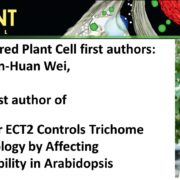
Recognizing featured Plant Cell first authors: Lian-Huan Wei
The Plant Cell, The Plant Cell: Author ProfilesLian-Huan Wei, first author of The m6A Reader ECT2 Controls Trichome Morphology by Affecting mRNA Stability in Arabidopsis
Current Position: PhD student in the Department of Chemical Biology, College of Chemistry and Molecular Engineering, Peking University.
Education: PhD in Chemical Biology at…
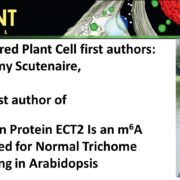
Recognizing featured Plant Cell first authors: Jérémy Scutenaire
The Plant Cell, The Plant Cell: Author ProfilesJérémy Scutenaire, first author of The YTH Domain Protein ECT2 Is an m6A Reader Required for Normal Trichome Branching in Arabidopsis
Current Position: Postdoc at the Institute of Genetic, Molecular and Cellular Biology (IGBMC), Illkirch, France
Education: PhD in plant molecular biology at the…
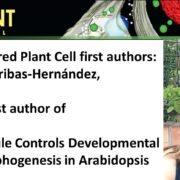
Recognizing featured Plant Cell first authors: Laura Arribas-Hernández
The Plant Cell, The Plant Cell: Author ProfilesLaura Arribas-Hernández, featured first author of An m6A-YTH Module Controls Developmental Timing and Morphogenesis in Arabidopsis
Current Position: Postdoctoral Researcher, University of Copenhagen.
Education: PhD in Biochemistry at the University of Copenhagen (2015), BS and MS in Biology at Universidad…
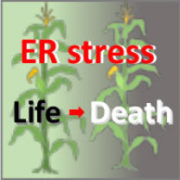
Plant scientists use big data to map stress responses in corn
Blog, The Plant Cell, The Plant Cell: NewsIowa State University
AMES, Iowa – Plant scientists at Iowa State University have completed a new study that describes the genetic pathways at work when corn plants respond to stress brought on by heat, a step that could lead to crops better capable of withstanding stress.
The findings, published…

ONE GENE: DIFFERENT mRNAs, DIFFERENT TISSUES, DIFFERENT FUNCTIONS IN DEVELOPMENT
Research, The Plant Cell, The Plant Cell: In a NutshellNapoli et al. show that mRNA splicing variants have tissue- and developmental stage-specific activity in flower development https://doi.org/10.1105/tpc.17.00840.
By Roberta Ghelli and Patrizia Brunetti
Background: Plants that are self-pollinating contain both male (stamen) and female (pistil)…

Pathogenic Bacteria Use A “Self-Eating” Process to Trick Plants
Research, The Plant Cell, The Plant Cell: In a NutshellÜstün et al. show that pathogenic Pseudomonas enhances the autophagic turnover of proteins in Arabidopsis https://doi.org/10.1105/tpc.17.00815.
By Suayib Üstün and Daniel Hofius
Background: Autophagy and the proteasome are the major pathways for protein degradation in eukaryotes. While the…
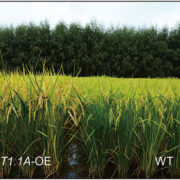
Developing High-Yield Early-Maturation Crops by Manipulating Nitrogen Utilization
Research, The Plant Cell, The Plant Cell: In a NutshellWang et al. investigate the function of OsNRT1.1A in rice. Plant Cell (2018). https://doi.org/10.1105/tpc.17.00809.
By Wei Wang, Bin Hu and Chengcai Chu
Background: To cope with an increasing global population and decreasing availability of arable land, improving crop yield is a major agricultural…

Clathrin-Mediated Endocytosis: Plant Homologs of the Clathrin Uncoating Factor Auxilin
Research, The Plant Cell, The Plant Cell: In a NutshellAdamowski et al. use CRISPR to investigate the function of plant auxilin proteins https://doi.org/10.1105/tpc.17.00785.
By Maciek Adamowski
Background: Endocytosis is one of the basic pathways of cellular trafficking. By endocytosis, proteins located in the plasma membranes, for instance receptors,…
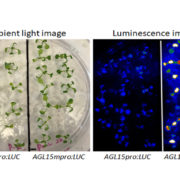
Switching off Seed Maturation Genes in Seedlings
Research, The Plant Cell, The Plant Cell: In a NutshellChen et al identify AGL15 as a direct target of HSI2-dependent transcriptional repression in Arabidopsis seedlings https://doi.org/10.1105/tpc.17.00655.
By Naichong Chen and Randy Allen
Background: The developmental transition from seeds to seedlings is a critical step in the plant life cycle.…

